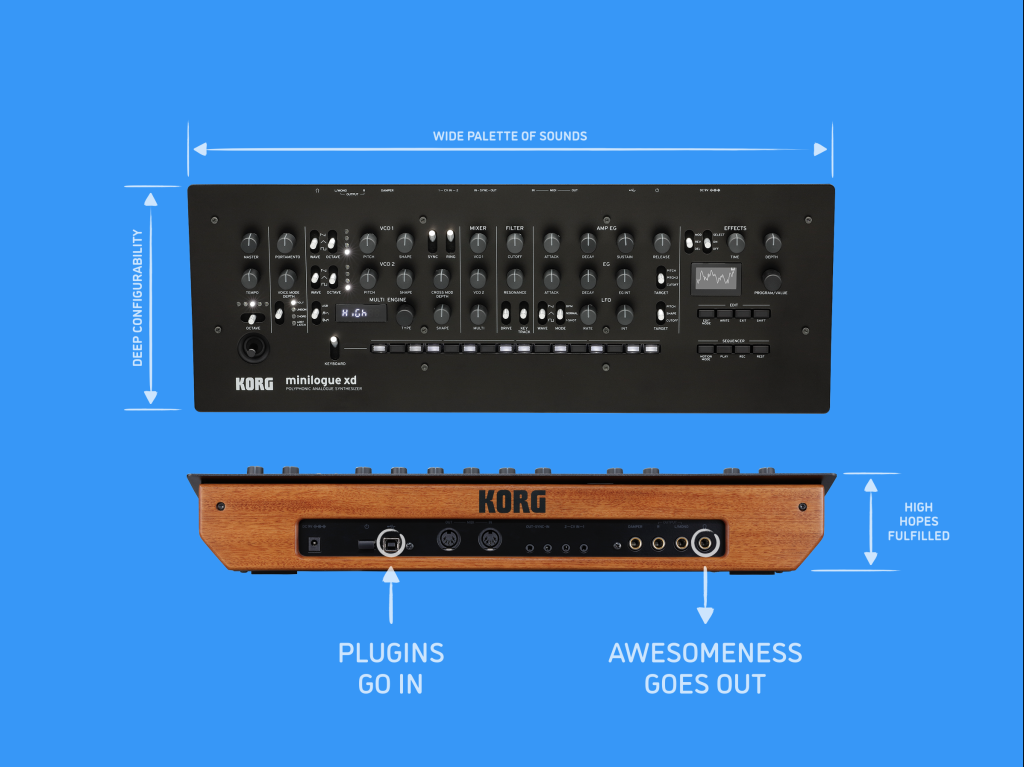No new ideas in synthesizers? Not so, says independent developer Artemiy Pavlov. He was excited enough about KORG’s direction that he’s written about why he thinks it changes music tech for the better.
The Ukraine-based coder who releases under his Sinevibes brand is someone we’ve followed on CDM for some years, as a source of very elegant Mac-only plug-ins. Making those tools for one company’s piece of hardware (one that isn’t Apple) is a new direction. But that’s what he’s done with KORG’s ‘logue plug-in architecture, which now runs on the minilogue xd and prologue keyboards, as well as the $100 NTS-1 kit. As long as you’ve got the hardware, you can run oscillators, filters, and effects from third-party developers like Sinevibes – or even grab the SDK and make your own, if you’re a coder.
Now, of course Artemiy is biased – but that’s kind of the point. What’s biased his one-man dev operation is that he’s clearly had a really great experience developing for KORG’s synths, from coding and testing, to turning it into a business.
This is not a KORG advertisement, even if it sounds like one. I actually didn’t even tell them it’s coming, apart from mentioning something was inbound to KORG’s Etienne Noreau-Hebert, chief analog engineer. But because it impacts both interested musicians and developers, I thought it was worth getting Artemiy’s perspective directly.
So here’s Artemiy on that – and I think this does offer some hope to those wanting new directions for electronic musical instruments. This is labeled “Op Ed” for a reason – I don’t necessarily agree with all of it – but I think it’s a unique perspective, not only in regards to KORG hardware but the potential for the industry and musicians of this sort of embedded development, generally. -Ed.

In early 2018, for its 50th anniversary, Korg introduced the prologue. It wasn’t just a great-sounding synthesizer with shiny, polished-metal looks. It introduced a whole new technical paradigm that has brought a tectonic shift to the whole music hardware and software industry.
Korg has since taken the concept of “plug-ins in mainstream hardware synths” further to much more compact and affordable minilogue xd and Nu:Tekt NTS-1, proving that it’s more serious about this than even I myself thought.
If you thought the platform just lets you load custom wavetables and store effect presets, you have no idea how much you’ve been missing! This is also for those who have been waiting for something that really looks to the future – and for anyone wanting to scale down their rig while scaling up their sonic palette. For me, as a control freak, I can now imagine new features from the moment I touched the synth – even though it’s someone else’s product.
Here are five ways Korg’s plugin-capable synths completely change the game for all of us, described both as before and after:

1. Personalization
Before. When you buy a synthesizer, all the features inside are what the manufacturer decided it should have. Each customer gets the exact same thing – same features, same sound.
After. With Korg’s hardware plugin architecture, the “custom” is finally back to “customer” – as you can configure the oscillator and the effect engines to your liking, and make your instrument unique. Fill it with the exact plugins you want, make it tailored to your own style. You have 48 plugin slots available, and chances are nobody else on the planet configures them the way you do.
2. Versatility
Before. While we do have digital and analog instruments with very capable synthesis and processing engines, to really get into more unusual or experimental sonic territory, you almost certainly need extra outboard gear – often a lot of it, which means more to transport and wire up.
After. The plug-ins now allow you to expand the stock generation and processing capabilities way beyond the “traditional” stuff, and have a whole powerhouse inside a single instrument. Just by switching from preset to preset, you can have the synthesizer dramatically shift its character, much as if you were switching from one hardware setup to another. Much less gear to carry, less things to go wrong, literally zero setup time.
Here’s what I mean, just with currently-available plug-ins. How about a sound-on-sound looper, or a self-randomizing audio repeater, right inside your synth?
And how about running unorthodox digital synthesis methods, in parallel with a purely analog subtractive one?
3. Independence
Before. With almost all gear, you are completely at the mercy of the manufacturer regarding what’s available for your instrument (aside from sound packs which still obviously can only use the stock features).
After. Not only you decide which engines your synth has, cherry-picking sound generation and processing plugins from independent developers, but you can also grab the SDK and build whatever you want yourself. [Ed. See below for some notes on just how easy that is.]
4. Longevity
Before. While some manufacturers might update their instruments with some major features from time to time, to be brutally honest, most won’t. Typically, just a couple years after initial release, you can consider the feature set in your synthesizer frozen… forever.
After. At any time in the future, you can erase some or even all the plug-ins on your synth and install different ones. So it can stay fresh and interesting for years or even decades, without you having to buy new hardware to get a new sound. The scale of your capabilities will actually only keep increasing as the selection of third-party plugins continues growing.
For example, say you have two different live projects. A single instrument can now represent two entirely different sets of sounds, using plugins and presets. In just a couple of minutes you can fully clean your Korg and reload it with a whole new “sonic personality” – no installers to run, no activation hassle, just transfer and go.
5. Range
Before. High-end features almost always command high-end prices, or a high level of coding experience to be able to work with that open-source firmware (in the rare cases when it’s actually available).
After. The ticket price for entry into this world of user-configurable synthesizers is Korg’s tiny and super-affordable monophonic Nu:Tekt NTS-1 (around $100), and it still has 48 plug-in slots just like its bigger brothers. Speaking of the bigger brothers, at the other end of the range we have the flagship 8- or 16-voice polyphonic prologue ($1500-2000), and 4-voice minilogue xd in both keyboard and desktop versions ($600-650). There’s now a plug-in-capable synth for everyone.
Which KORG do you want?
So, which one to choose? Each of the models has its unique advantages and unique ways it can integrate into your existing setup – or create a totally new one. [Ed. I’ve confirmed previously with KORG that all three of these models is equally capable of running this plug-in architecture. There’s also the fourth developer board that Artemiy doesn’t mention, though at this point you’re likely to get the NTS-1.]
NTS-1 is probably the most quirky of the lot, but is also surprisingly versatile for its tiny size. First, it can be easily powered off any portable battery, and second, it has a stereo input that lets you run any external audio through up to three different plugin effects, silently making it “the stompbox of your dreams.”
The mid-range minilogue xd doesn’t have an external input, but does have a very compact and portable body, and a note sequencer. The sequencer can be used together with the arpeggiator for extra-long evolving melodies, but also has 4 parameter automation tracks – with all this data stored per each preset.
The key feature of range-topping prologue, aside from its incredibly pleasant-to-play keybed and sleek all-metal controls, is the fact that each of its presets can be constructed out of two completely separate, split, or layered patches – meaning that you can load two oscillator plugins at the same time.
Developers, developers, developers
How easy is it to develop your own Korg plugin?
First of all, I can tell you that running my own algorithms on a hardware synth was something I have dreamed of for years. Apart from a very unlikely collaboration with the manufacturer, or digging deep into someone’s rare open-source firmware, I figured the chances of actually doing that were zero.
Luckily, Korg has made it so much easier for me and you, that you would almost be guilty for not giving coding your own little plug-in a go. Allow me to give you a first-person example of what it took to get started.
Korg’s loque-SDK is a collection of source code files and a toolchain that runs via the command line in the terminal app. For each type of plug-in, Korg provides a sample – there’s a simple sine oscillator, there’s a delay, a filter, etc. – and the best way for you to start is modify one of them slightly.
You don’t need to do much. For example, make the sine oscillator produce a mix of two sines, one running an octave above the other. You’d simply multiply the second sin() function’s argument by 2 and add it to the first one — that’s it. That’s exactly what I did, and I was hooked instantly.
Now you build the plugin using the “make” command, and install the file onto whichever of the synthesizers in the family you have. You do that via its “sound librarian” companion app into which you simply drag and drop your plugin while the synth is connected via USB.
https://github.com/korginc/logue-sdk
Now go
All this said, I hope this has changed how you look at Korg’s plugin-capable synthesizer architecture. Because, and I am really confident when I say this, Korg did go and change the whole industry with it.
https://www.sinevibes.com/korg/